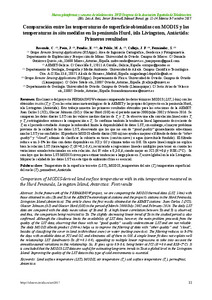Por favor, use este identificador para citar o enlazar este ítem:
http://hdl.handle.net/20.500.11765/14301
Comparación entre las temperaturas de superficie obtenidas con MODIS y las temperaturas in situ medidas en la península Hurd, isla Livingston, Antártida: Primeros resultados
| Título : | Comparación entre las temperaturas de superficie obtenidas con MODIS y las temperaturas in situ medidas en la península Hurd, isla Livingston, Antártida: Primeros resultados |
| Otros títulos : | Comparison of MODIS-derived land surface temperatures with in situ temperatures measured in the Hurd Peninsula, Livingston Island, Antarctica: first results |
| Autor : | Recondo, María del Carmen; Peón, Juanjo; Pendás, Enrique |
| Palabras clave : | Temperatura de la superficie terrestre (LST); MODIS; Temperatura del aire (Ta) temperatura superficial del suelo (Ts); Permafrost; Antártida; Land surface temperature (LST); Air temperature (Ta ) soil surface temperature (Ts ); Antarctica |
| Fecha de publicación : | 2017 |
| Editor: | Universitat Politècnica de València |
| Citación : | Ruiz, Luis Ángel, Estornell, Javier, Erena, Manuel (Eds.). Teledetección: nuevas plataformas y sensores aplicados a la gestión del agua, la agricultura y el medio ambiente. [Valencia]: Universitat Politècnica de València, 2017, pp. 11-14 |
| Resumen : | [ES]En el marco del proyecto PERMASNOW estamos comparando los datos térmicos MODIS (LST, 1-km) con los
obtenidos in situ (Ta
y
Ts)
en las estaciones meteorológicas de la AEMET y las propias del proyecto en la península Hurd,
isla Livingston (Antártida). Este trabajo muestra los primeros resultados obtenidos para las estaciones de la AEMET:
Juan Carlos I (JCI), Glaciar Johnson (GJ) y Glaciar Hurd (GH) en el periodo marzo-2000/julio-2002 y febrero-2016. Se
comparan los datos diarios LST con los valores medios diarios de
Ta
y
Ts.
Se observa una alta correlación lineal entre
Ta
y
Ts,
restringiéndose entonces la comparación a
Ta.
Se confirma también la tendencia lineal ligeramente decreciente de
Ta
en el periodo estudiado. Aunque la nubosidad limita la disponibilidad de datos LST, sin embargo, el mayor problema
proviene de la calidad de los datos LST, observando que los que no son de “good quality” generalmente subestiman
mucho LST y no son fiables. El producto MODIS-albedo diario (500-m) nos ayuda a mejorar el filtrado de datos de “other
quality” y “cloud”, además de clasificar la cubierta en tierra (con/sin nieve) o agua (nieve/hielo fundido). El filtrado
reduce a un 3-8% los días con datos disponibles en JCI y GJ y elimina todos en GH. Un ajuste lineal simple no explica
bien la relación LST (tierra/agua)-Ta
(R2=0,1-0,4), recurriendo a regresiones lineales múltiples para tener en cuenta las
variaciones anuales/estacionales en esta relación. Así R2 sube a 0,3-0,6, siendo mejor en JCI (R2=0,6 y RSE~2°C). Se
concluye que los datos LST-MODIS sirven para estimar tendencias a largo plazo en
Ta
a nivel global en la isla Livingston.
Mejorar la calidad de los datos LST en este tipo de ambientes fríos es esencial. [EN]In the framework of the PERMASNOW project, we are comparing the MODIS thermal data (LST, 1-km) with those obtained in situ (Ta and Ts) at the AEMET meteorological stations and the project’s stations in the Hurd Peninsula, Livingston Island (Antarctica). This article shows the first results obtained at the AEMET stations: Juan Carlos I (JCI), Glacier Johnson (GJ) and Glacier Hurd (GH) in the period of March-2000/July-2002 and February-2016. The daily LST data are compared with the daily mean values of Ta and Ts. A high linear correlation between Ta and Ts is observed, and thus, the comparison being restricted to Ta. The slightly decreasing linear trend of Ta in the studied period is also confirmed. Although the cloudiness limits the availability of LST data, however, the main problem proceeds from the quality of the LST data, observing that those with no “good quality” usually underestimate LST and are not reliable. The daily MODIS albedo product (500-m) helps us to improve the filtering of data with “other quality” and “cloud”, besides of classifying the cover in land (with/without snow) or water (melting snow/ice). The filtering reduces to 3-8% the days with available data at JCI and GJ, and eliminates all of them in GH. A simple linear fit does not explain well the relationship LST (land/water)-Ta (R2=0.1-0.4), appealing to multiple linear regressions to take into account the annual/seasonal variations in this relationship. So, R2 goes up to 0.3-0.6, being better at JCI (R2=0.6 and RSE~2°C). It is concluded that the MODIS-LST data are useful for estimating long-term trends in Ta at a global level in the Livingston Island. Improving the quality of the LST data in this type of cold environments is essential. |
| Descripción : | Ponencia presentada en: XVII Congreso de la Asociación Española de Teledetección celebrado en Murcia, del 3 al 7 de octubre de 2017. |
| Patrocinador: | Este trabajo ha sido financiado por el Ministerio de Economía y Competitividad (MINECO), a través del proyecto PERMASNOW (CTM2014-52021-R). |
| URI : | http://hdl.handle.net/20.500.11765/14301 |
| ISBN : | 978-84-9048-650-4 |
| Colecciones: | Congresos AET (Asociación Española de Teledetección) |
Ficheros en este ítem:
| Fichero | Descripción | Tamaño | Formato | ||
|---|---|---|---|---|---|
| XVII_Congreso_AET_1.pdf | 650,66 kB | Adobe PDF |  Visualizar/Abrir |
Los ítems de Arcimis están protegidos por una Licencia Creative Commons, salvo que se indique lo contrario.





